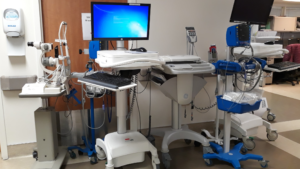
Historical Analytics a Must-Have for Healthcare

Whether a large hospital or a small-town clinic, healthcare facilities depend on complex and dynamic wireless ecosystems. These systems – sometimes consisting of tens of thousands of medical, business, and personal devices – change from one hour to the next. Every time a client device connects or disconnects, or providers and patients move throughout a building, or even as devices upgrade, the wireless ecosystem is affected. Optimizing this vast network so that it always provides reliable and strong service is a complicated process. IT teams need constant visibility into the entire ecosystem. Every time the wireless network experiences a problem, IT may have to analyze thousands of data packets in order to narrow down the root cause of the issue. They must answer questions like:
- Was the problem caused by a device? An application? Network infrastructure?
- Is the network overloaded?
- Did an update cause interference issues? Or is the issue caused by devices that are outdated?
- Can the issue be narrowed down to one room, one floor, or one building?
Add in the fact that most issues are intermittent, making it even more complicated to isolate the necessary data packets, and it’s obvious that network optimization and troubleshooting are full-time jobs. Is there anything that facilities can do to make this work easier? Absolutely. A three-pronged approach that combines WiFi Assurance, proactive solutions, and historical analytics removes WiFi mysteries and eliminates problems. With the first two prongs discussed in previous posts, we’ll focus on historical analytics here.
Historical Analytics
Using historical data, healthcare facilities can predict future wireless network performance. They can make informed decisions about how to update and upgrade the network based on performance analytics gathered over the last few weeks and months. This allows networks to be optimized efficiently, effectively placing healthcare organizations one-step ahead in the never-ending push for better performance, rather than sticking them in reactive-only mode.
Historical data reveals changes in:
- Client capacity
- Client distribution
- Airtime and client utilization
- Infrastructure health
- Network response times
With this data, hospitals and other facilities know exactly how network usage and performance have changed over time, and can better determine how the wireless ecosystem needs to grow. This leads to efficient and effective budget and capacity planning, allowing a facility to respond to its specific needs, rather than market trends.
Healthcare facilities can:
- Identify growing capacity requirements for specific applications as well as the needed bandwidth requirements for all users
- Determine changes in peak and average demand, and which areas of a hospital or clinic have consistent high demand
- Reduce costs by identifying savings opportunities – for example, if there is excess capacity
- Promote optimization by eliminating bottlenecks
- And more
Additionally, with these analytics supporting network optimization, facilities will see an improved end user experience for patients, providers, and guests. For example, a reliable network means that all medical data will be relayed in real-time supporting patient care, care coordination between teams and facilities is made easier, communication with friends and family is supported, and online appointment scheduling and check-ins are easy and quick.
Network Optimization
With its AI-based engine, the Wireless Intelligence Platform (WIP) provides optimized WiFi reliability, performance, and visibility. With its 24/7 proactive detection, notification, and mitigation, WIP not only delivers unparalleled real-time insights, but also detailed historical analytics.
With WIP, hospitals and clinics can review past data on specific devices as well as on the health of the overall wireless network. Because WIP automatically saves data from the past day, week, and month, hospitals can study network events in depth, even if the exact conditions in question no longer exist. Did something happen to a clinic’s network overnight, when no one was onsite? Check WIP for the details. Were WiFi 6 APs and client devices added to a hospital and administrators need to know how/if performance improved over the last three months? Check WIP.
WIP automatically creates graphs that display trends over time with data on access points, client distribution, and airtime and client utilization. These graphs provide a clear visual of what the network is asked to support, how that affects performance, and how it has changed throughout the past year. The graphs can be easily exported and shared to support efficient budget and network capacity planning. With these details, WIP supports healthcare facilities not only in making decisions for the present health of the network, but also in making changes for the future.
In healthcare, wireless networks directly support the health and wellbeing of all patients. Optimizing a network isn’t only good for business, it’s important for an end user experience that promotes physical, mental, and emotional health. Healthcare networks must always guarantee consistent and reliable performance for all connected devices and applications. By providing in-depth historical analytics, WIP provides teams with the critical information that they need to design a network that remains optimized into the future – before the future arrives.

